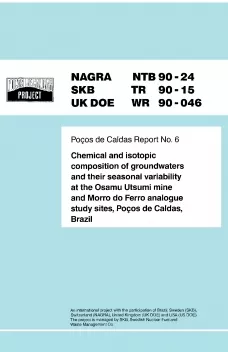
Technical Report NTB 90-24
Chemical and isotopic composition of groundwaters and their seasonal variability at the Osamu Utsumi mine and Morro do Ferro analogue study sites, Poços de Caldas, Brazil
Groundwaters and a few surface waters were collected over a period of 3 years from two natural analogue sites near Poços de Caldas, Brazil: the Osamu Utsumi uranium mine and the Morro do Ferro thorium/rare-earth deposit. These were analysed for major constituents, several trace elements, tritium, deuterium and 18O, to provide hydrochemical data for the modelling objectives as defined within the natural analogue study programme. The groundwaters are a K-Fe-SO4 type, which classifies them as a highly unusual composition related to the weathering of a hydrothermally altered, mineralised complex of volcanic to sub-volcanic phonolites.
A subset of selected constituents (Fe(II), Fe(total), SO4, pH, Eh, alkalinity, F and U) was monitored to gain detailed information on the seasonal variability. Seasonal patterns were only apparent from the very shallow groundwater data, but a trend of continuously increasing dissolved solids for the furthest down-gradient sampling point in deep groundwater indicates a growing plume of water affected by pyrite oxidation but without the residual acidity. Tritium and stable isotope measurements indicate that all groundwaters are of meteoric origin and are not affected significantly by evaporation or by water-rock interactions. Recharging groundwaters at both study sites demonstrate infiltration of water of less than about 35 years in age, whereas deep groundwaters are below 1 TU (tritium unit) but still contain detectable tritium in most cases. These deeper groundwaters may be interpreted as being 35 – 60 or more years in age, resulting mainly from an admixture of younger with older groundwaters and/or indicating the influence of subsurface-produced tritium.
